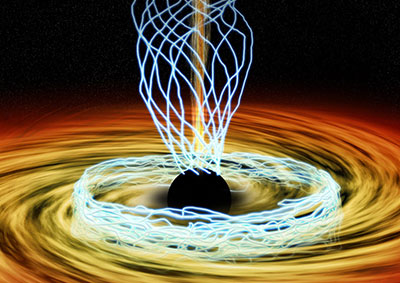
On December 4, the journal Science (Vol. 350 no. 6265 p 1242) published a paper titled, “Resolved magnetic-field structure and variability near the event horizon of Sagittarius A*” (abstract). The paper reports that the Event Horizon Telescope has detected strong magnetic fields around the supermassive black hole at the center of the Milky Way galaxy. John Wardle, Professor of Astrophysics at Brandeis, is one of the lead authors. A co-author is Michael Kosowsky ’14, who worked on the project as a summer research project at the MIT-Haystack observatory as a junior physics major, and is now an NSF Graduate Research Fellow at Harvard.
Near a black hole, differential rotation of a magnetized accretion disk is thought to produce an instability that amplifies weak magnetic fields, driving accretion and outflow. These magnetic fields would naturally give rise to the observed synchrotron emission in galaxy cores and to the formation of relativistic jets, but no observations to date have been able to resolve the expected horizon-scale magnetic-field structure. The paper reports interferometric observations (made with antennas in Hawaii, California and Arizona) at 1.3-millimeter wavelength that spatially resolve the linearly polarized emission from the Galactic Center supermassive black hole, Sagittarius A*. We have found evidence for partially ordered magnetic fields near the event horizon, on scales of ~6 Schwarzschild radii, and we have detected and localized the intra-hour variability associated with these fields.
The above image is an artist’s impression. With the planned addition of antennas in Mexico, Chile, Europe and the South Pole, the Event Horizon Telescope will be able to make true images with angular resolution of a few tens of microarcseconds.
